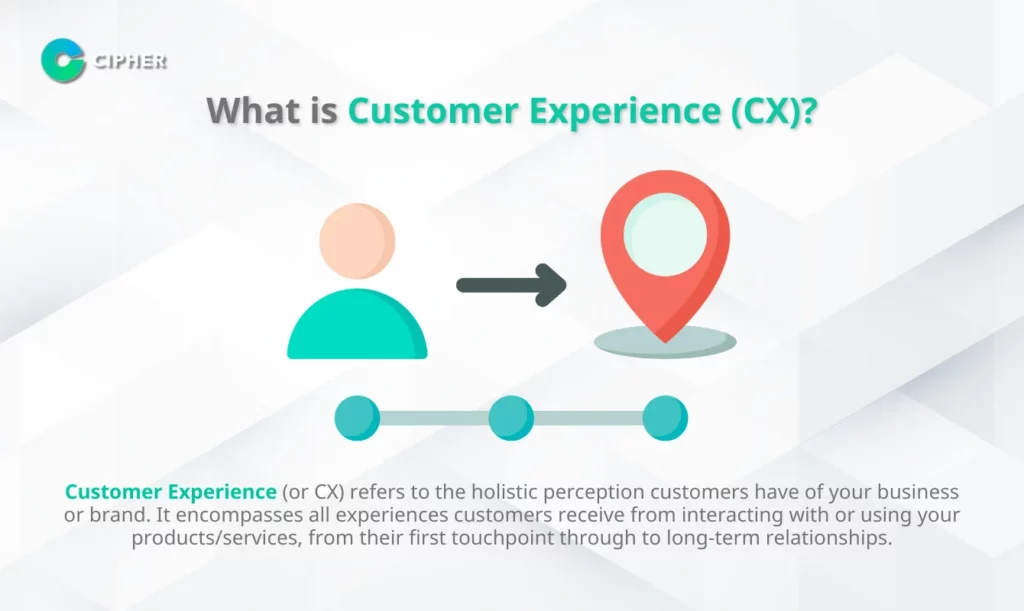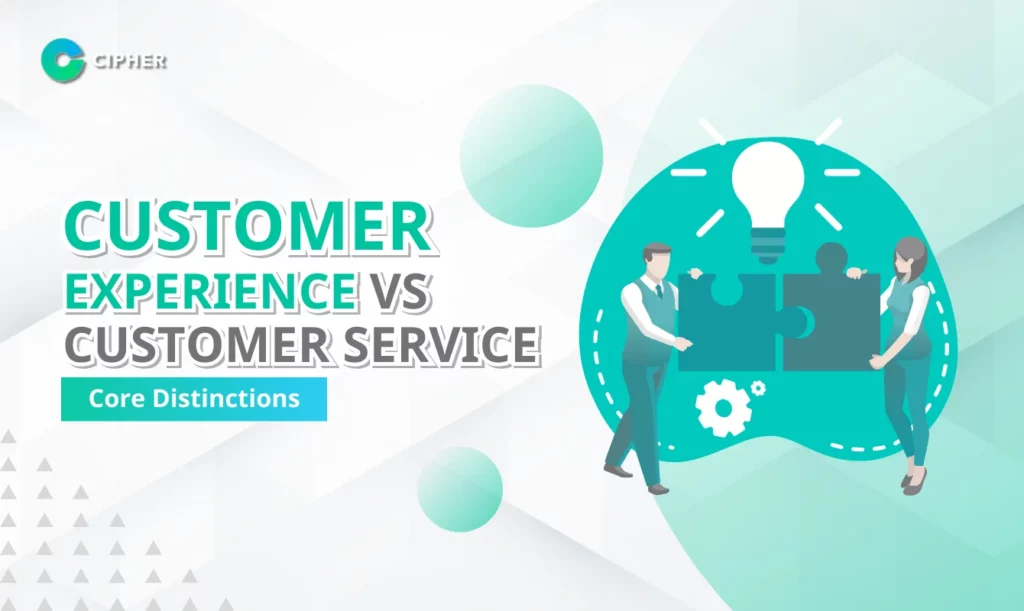Table of Contents
What is Customer Experience (CX)?

Customer Experience (or CX) refers to the holistic perception customers have of your business or brand. It encompasses all experiences customers receive from interacting with or using your products/services, from their first touchpoint through to long-term relationships. Customer Experience includes every interaction customers have with your brand throughout their customer journey, whether visiting your website, using your application, talking with employees, or experiencing your products and services.
CX involves analyzing data about customer behaviors, including shopping patterns, lifestyle preferences, interests, and platform usage, to create personalized analyses. This allows businesses to offer products or services that precisely match customer needs. The goal of Customer Experience Marketing is to ensure customers receive excellent experiences from every interaction with your brand across all touchpoints. Professional digital marketing agencies like Cipher understand that effective CX is fundamental to building lasting customer relationships.
What is Customer Service? And What Does Customer Service Do?
Customer Service is the assistance and support provided to customers during, before, and after using your services. It’s a process focused on solving problems and responding to customer needs when issues arise or questions emerge.
What does Customer Service do? The primary functions of Customer Service include:
- Providing information about products and services
- Handling complaints and resolving problems
- Offering technical advice and assistance
- Answering customer questions and concerns
- Managing product returns and refund processes
- Listening to customer feedback and suggestions
- Customer Service is just one touchpoint in the overall customer experience.
Examples include calling a service center for a refund or contacting staff via email to inquire about information.
How Do Customer Experience and Customer Service Differ?

While Customer Experience and Customer Service are related, they have significant differences:
- Scope: Customer Experience has a broader scope, covering all aspects of interaction between customers and the brand, while Customer Service is merely one component of Customer Experience.
- Timeframe: Customer Experience occurs throughout the entire customer journey, from pre-purchase to purchase and post-purchase, while Customer Service typically happens when customers need assistance or have problems.
- Goals: Customer Experience focuses on creating long-term impressions and satisfaction, while Customer Service aims to solve problems and respond to customer needs at specific moments.
- Measurement: Customer Experience is measured by overall customer satisfaction, brand loyalty, and word-of-mouth, while Customer Service is measured by resolution speed and service satisfaction.
In summary, Customer Service is part of Customer Experience. Both are important for business success, but Customer Experience has a broader scope and covers all aspects of the relationship between customers and brands. According to research by Zendesk, investing in customer experience can lead to significant competitive advantages and improved financial performance.
Why is Customer Experience Important for Business?
In an era where consumers have many choices, creating good customer experiences is a key to business success. Customer Experience Marketing has become an essential strategy that businesses must pay attention to. Here’s why Customer Experience is critically important:
- Increases customer loyalty: Customers who receive good experiences are likely to return to purchase products or use services again and become regular customers. This loyalty is a crucial component of your overall marketing mix, working alongside product, price, place, and promotion strategies.
- Creates word-of-mouth: Impressed customers will recommend your brand to people around them, which is the most effective and credible form of marketing, especially on social media platforms where professional social media management can amplify these recommendations.
- Increases sales: Research shows that 86% of customers are willing to pay more for better experiences.
- Creates differentiation: In highly competitive markets, creating outstanding customer experiences is the best way to distinguish your brand from competitors.
Interesting Statistics on the Importance of Customer Experience:
- 51% of customers switch brands after just one bad experience (report from Helpscout)
- 80% of organizations expect to compete mainly through CX (report from Gartner)
- 81% of companies see customer experience as a differentiator from competitors (report from Cision PR Newswire)
- 89% of businesses compete primarily on Customer Experience (report from Gartner)
- 46% of customers are willing to pay more when brands can deliver personalized experiences
Therefore, understanding the difference between Customer Experience vs Customer Service is an essential foundation for setting effective business strategies in today’s era.
Key Components of Customer Experience (CX) and How to Create Customer Experiences
1. Discovery
2. Engagement
3. Delivery
7 Key Components of Customer Experience Management
1. Customer Insight
2. Personalization
3. Consistency
4. Research & Development
5. Innovation & Technology
6. Customer Satisfaction
7. Employee Engagement
5 Ways to Prepare for Customer Experience Implementation
1. Understand Target Audience Behaviors
2. Plan Work Clearly
3. Execute Efficiently
Execution has 3 key parts:
- Touch points: What channels do customers use to contact your brand?
- Interactions: Quality of communication between employees and customers
- Engagement: Opportunities to create impressions for customers
4. Create Transparency for Your Brand
5. Measurement
There are 2 main methods to measure customer satisfaction:
- CSAT (Customer Satisfaction Score): The more positive answers, the higher the score
- NPS (Net Promoter Score): Measures how likely customers are to recommend your services or products to others, helping measure customer loyalty
5 Strategies to Create Good Customer Experiences
1. Empower Employees
2. Value Employee Ideas
3. Use Technology to Create Customer Experiences
Using technologies like AI or Chatbots helps customers contact and inquire anytime, making customers feel special and well-cared for. Technology also helps collect data and analyze customer behaviors efficiently. Modern enterprise CMS solutions can play a crucial role in delivering consistent content experiences across all digital touchpoints.
4. Be Ready to Receive Feedback from All Channels
Using Omnichannel is an important change in doing business and goes hand-in-hand with CX implementation. Today’s customers use multiple channels to contact brands, both online and offline. Effective social media marketing strategies can capture valuable feedback and engage customers where they spend much of their time. The smooth flow of customer information is crucial for providing consistent and coherent experiences.
5. Use a Top-Down Approach
7 Customer Experience Statistics Businesses Must Watch
1. Challenges in Understanding Customers
2. AI Has a Significant Impact on Customer Experience
3. Customers Prefer Self-Service Channels
4. Customers Expect More Targeted Communications
5. Customers Expect Problem Resolution Within 3 Hours
6. Customer Service Should Connect All Channels Seamlessly
7. Developing Customer Retention and Loyalty is the Highest Priority
31% of Customer Service leaders give highest priority to Customer Retention and Customer Loyalty instead of focusing on finding new customers or offering short-term discounts. Building strong relationships with customers will lead to long-term success.
Additionally, Customer Service leaders also prioritize offering personalized experiences (26%), understanding and implementing customer feedback (25%), and improving Customer Experience operational processes (25%).
How CRM Systems Help Improve Customer Experience
Good CRM (Customer Relationship Management) systems can help elevate Customer Experience efficiently. Since CX is part of CRM, marketing tools that help maintain customer relationships will result in customers receiving good experiences and becoming regular customers more easily. Understanding the benefits of CRM systems is essential for businesses looking to enhance their customer experience strategy.
CRM systems can help develop Customer Experience as follows:
- Membership Systems: Help segment customers in diverse and flexible ways, allowing you to offer special benefits to each customer group according to their needs
- Point Collection Systems: Stimulate repeat purchases through point collection for rewards, creating long-term sales
- POS Programs: Help make store management more efficient, like having a store manager to assist at all times
- Customer Data Collection: Helps understand customer needs and behaviors, allowing offerings of products or services that match their needs
- Data Analysis: Helps see trends and opportunities to improve services and communications with customers
Implementing the right CRM solution can transform how businesses interact with customers across all touchpoints, creating a more personalized and satisfying experience that builds loyalty over time.
Elevate Your Business with Comprehensive Customer Experience Management
At Cipher, we are committed to providing comprehensive Customer Experience Management services to help your business elevate customer experiences and create competitive advantages.
Our services:
- Customer Journey Analysis and Design: We help analyze all customer touchpoints with your brand and design smooth and impressive Customer Journeys
- CRM System Development: We develop CRM systems that meet your business’s specific needs to help manage customer relationships and collect data efficiently
- Omnichannel Marketing: We help you connect with customers seamlessly across all channels, both online and offline
- Employee Training: We provide training for your employees on customer care and creating good experiences so they can deliver services that exceed expectations
- Data Analysis and Measurement: We help you measure the success of Customer Experience implementation and provide recommendations for continuous improvement
As experts in digital marketing, social media management, and customer relationship strategies, we understand how to integrate all aspects of your marketing mix to create exceptional customer experiences.
Let us be part of helping elevate your business with superior Customer Experience. Contact us today for free consultation!
Conclusion: The Importance of Customer Experience vs Customer Service in the Digital Era
In the digital era where online connection is the main channel and customers have higher expectations of brands, creating satisfaction with products or services alone may no longer be sufficient. Businesses need to find new ways to attract and retain customers. Focusing on Customer Experience Marketing is thus a key strategy that will help businesses succeed in the long term.
The difference between Customer Experience vs Customer Service is important for businesses to understand. CX is a process covering all touchpoints customers have with the brand, while Customer Service is just one part of the overall experience. Customer Experience covers all aspects of interaction between customers and brands throughout the Customer Journey. Prioritizing both Customer Experience and Customer Service will help businesses create impressions and loyalty from customers sustainably.
Investing in creating good customer experiences is not just a temporary trend but a necessary strategy for business survival and growth in an era where customers have more power of choice. Using technology, training employees, and improving work processes to deliver the best experiences to customers will help your business stay ahead of competitors and succeed in the long term. The more you understand the difference between Customer Experience vs Customer Service, the more you can develop effective marketing strategies.
Frequently Asked Questions
What is the function of Customer Experience?
What does Customer Experience mean?
What does Customer Experience include?
Customer Experience includes:
- Interactions with the brand through various channels, both online and offline
- Quality of products and services
- Customer service and problem-solving
- Convenience and ease of use
- Personalized and targeted communications
- Consistency of experiences at all touchpoints
What is Customer Experience Management?
Customer Experience Management (CXM) is the process of strategizing and managing all interactions between customers and the organization to ensure customers receive the best experiences. CXM includes collecting customer data, analyzing needs, designing appropriate experiences, and measuring for continuous improvement.





